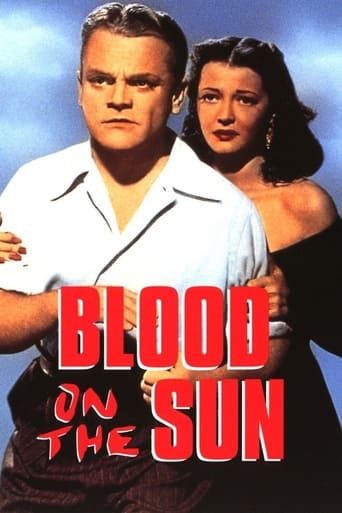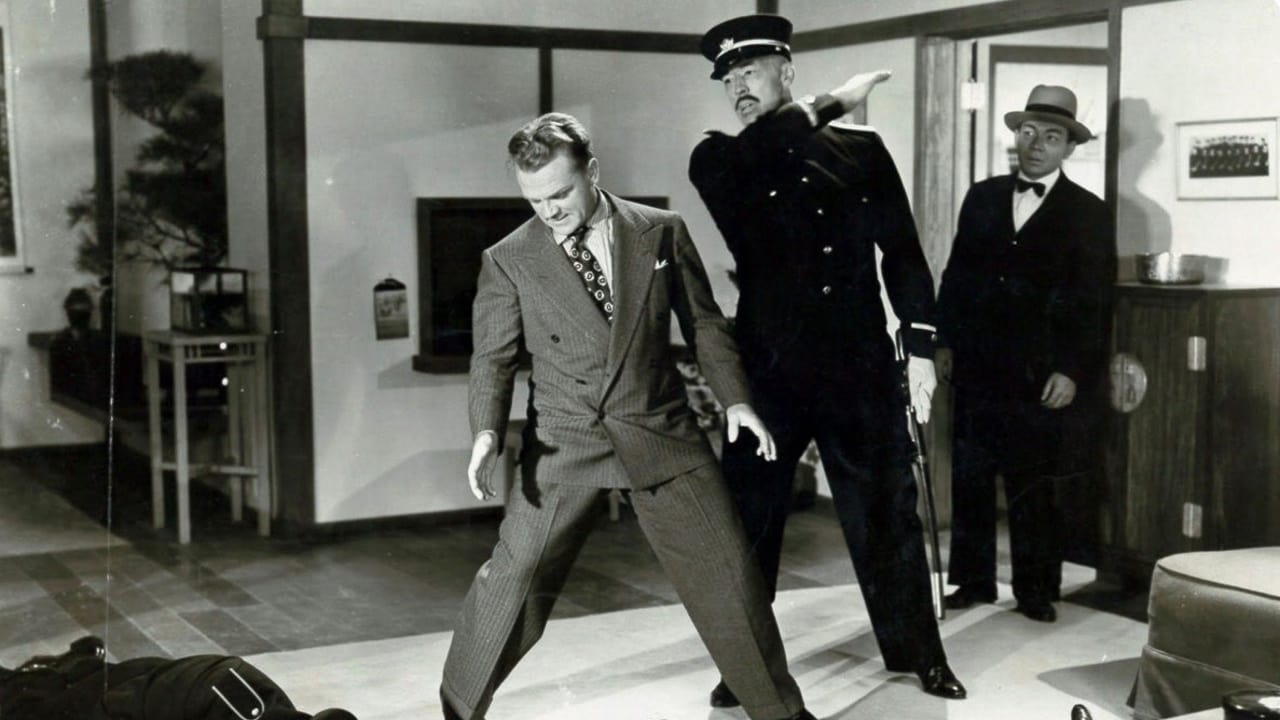bnwfilmbuff
Hokey WWII propaganda film with Tokyo-based newspaper man Jimmy Cagney exposing the Japanese duplicity with their relationships with China and the US and their intention for world domination. There's plenty of intrigue with spy Sylvia Sidney apparently trying to get the Tanaka Memorial (Japanese war plans) from Jimmy on behalf of the Japanese. Jimmy successfully takes on most of the Japanese police force and avoids being shot and killed by a small army at point blank range. His romantic relationship with lovely Sidney doesn't quite hit the mark. The cast is good as is the acting. But there are many inconsistencies throughout that diminish the film's credibility. The ending is reminiscent of Casablanca - I expected the line "This is bigger than the both of us". Okay for Cagney fans.
jakob13
Released in April 1945, 'Blood in the Sun' groans. It is an interesting film in some ways. Jimmy Cagney produced it. Nazi Germany was a month away from defeat, thereby ending the war in Europe. But the war raged furiously in the Pacific as the Americans island hopped getting closer to the Japanese mainland. And though the war was lost in southeast Asia, China and in chains of islands in the Pacific, Japanese troops fought tenaciously, but wouldn't give up. It is noteworthy for the script written by Lester Cole, one of the Hollywood 10. Cole narrative uses the 'Tanaka Memorial', a 1929 document (of doubtful authenticity) outlining Japan's plan of conquest in Asia. The US movie- going public knew of Hitler's 'Mein Kampf' and saw endless films on Nazi conquest in Europe and the like. But knew little of Japan other than its bombing of Pearl Harbor, its cruel war in China, as well as rudely trouncing the British and the French in southeast Asia, and to make matters worse coming close in Burma to rattling the pillars of the British Raj in India. Of course, they knew of the Flying Tigers and the valiant Americans fighting the Japanese in American Philippines. But of Japanese history, they knew little as did America's government. (They also knew of the rounding up the American Japanese on the west coast for the simple reason, they were Japanese and put them behind barbed wire in camps. But they left them alone in Hawaii for the plain and simple reason they make a good percentage of the population there.) 'Blood in the Sun' is interesting to another degree: the blatant use of stereotypes, of depicting the Japanese as primitive, childlike or madmen or all three and possibly more. All the principle characters are western or made up to look like Japanese, speaking with stilted accents. Which should not surprise us if we had seen the part on Asia of Frank Capra's 'Why We Fight', a multi-paneled film to explain isolationist Americans in the armed services why the US was waging war globally--it is blatantly racist, and superior to a 'small people' wily and evil and warlike with the bare trappings of the civilized. 'Blood in the Sun' is simplistic, and is a film shaped to the talents of a spunky, quixotic Cagney, who out talks, out wits and out judo his adversaries. The energy he exudes is best seen in his last last film, Billy Wilders' 'One, two, three'. 'Blood in the Sun' won the Oscar for Best Direction in Black & White in 1946. It grossed more than $3 million at the box office. Seeing it today, 70 years after its release, blow away the cobwebs and seeing spunky Cagney and the beautiful Sylvia Sydney isn't too hard on the eyes.
morrison-dylan-fan
Despite my dad owning a number of his films on DVD,I have somehow up to now only seen James Cagney in the overlooked 1935 movie G-Men. (which in no way is related to X-Men!)Talking to a friend recently,I discovered that he was interested in seeing Cagney's non-gangster titles,which led to me deciding that it would be a good time to see Cagney cover the sun with blood.The plot:Being credited as the editor who saved the paper from folding,Tokyo Chronicle editor Nick Condon begins to suspect that he may have just grabbed the story of the decade,thanks to an informant giving him a document titled "The Tanaka Memorial",which contain details about Japan's planned invasions for world domination.With having enjoyed a high amount of press freedom whilst working at the paper,Condon begins to suspect that he may have gotten hold of something very important,due to a number of police officers and politician's suddenly becoming extremely aggressive towards the paper.Fearing that he and Chronicle are at increasing risk of being permanently shut down,Condon rushes to publish the story,as he begins to find out how far the police,army and politician's are willing to go to keep the document out of the public's eye.View on the film:Made just as WWII was coming to an end,and also just before questions about the real Tanaka Memorial began to get raised, (with the document now being seen as a fake,designed to get the Alieies on the side of China's Communist party,which it succeeded in doing) the screenplay by Lester Cole,Frank Melford,Garrett Fort and Nathaniel Curtis initially make the movie appear that it is going to take a close look at the blurred lines separating the government and the press.Sadly,despite director Frank Lloyd and art directors A.Roland Fields and Wiard Ihnen, (who would both win an Oscar for their work in the title) covering the movie with tense darken alleyways and low-lit lighting,the screenplay burns out after the first 30 minutes,with the exciting espionage moments in the film being drained of their energy by the writer's jumbling them up,instead of allowing each double cross/close escape to twist naturally.Being filmed as his second feature to be from his own production company,James Cagney gives a rattling performance as Nick Condon,with Cagney showing Condon gradually becoming increasingly distrusting of all those around him as he gets closer to hitting the dead line.Along with Condon using his quick-wit to out smart the dark forces at power,Cagney also displays a surprising skill for excellent stunt work,thanks to the movie featuring a number of great,rough'n' tumble judo battles,all of which are not performed by a stunt person,but are in fact done by Cagney himself (something which Cagney would continue training with,long after the movie had been completed),which leads to this blood stained sun being one that wont fully fade out into a total eclipse.
wes-connors
James Cagney (as Nick Condon) is a reporter in Tokyo; a dutiful, precognizant American, he confronts the increasing grip of Fascism on the Japanese people, during the reign of Tanaka Giichi. Sylvia Sidney (as Iris Hilliard), is a mysterious part-Chinese woman, who provides Mr. Cagney with intrigue and romance. While Ms. Sydney is somewhat successful in her portrayal, the other Japanese impersonations are embarrassing. The movie bases much of its storyline on the existence of the "Tanaka Document", a Hitler-type blueprint for evil, which was more likely a propagandist's creation. Under these circumstances, Cagney and company's attempt to produce convincing entertainment collapses.


 AD
AD



